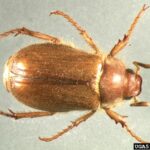The Columbia Shuswap Invasive Species Society (CSISS) and the Province (Ministry of Agriculture and Food) has officially confirmed the presence of Chafer Beetles in Revelstoke, marking a significant development for our community. While Chafer Beetles are not currently regulated pests, their appearance in our area necessitates immediate action to mitigate their impact and protect our local environment.
Ministry of Agriculture and Food Recommendations:
The Ministry of Agriculture recommends proactive treatment of affected turf to minimize potential damage caused by the Chafer Beetles. They strongly advise utilizing Acelepryn, a highly effective commercial product specifically designed for this purpose. The optimal timing for the application of Acelepryn is now. “Acelepryn needs only one application per year on turf, safe for use in urban areas, but it is a commercial product so licensed landscape applicators need to apply it” stated a representative from the Ministry of Agriculture in correspondence with CSISS.
Alternatively, if residents prefer to use the microbial product (Bacillus thuringiensis var galleriae), it should be applied later in mid June to early July, once eggs are laid and the beetles are in flight. Please note that this microbial product may be marketed under various trade names, such as Beetle Gone , this is a commercial product that must be applied by licensed landscape applicator. Grub B Gone, is a domestic product that can be used but may not be as effective. Predatory nematodes can be applied during the summer months when the Chafer Beetle grubs have recently hatched or are small (July-August). These nematodes are particularly suitable for urban areas but require precise application techniques including continued watering of lawns, which may not be viable if there are any water use restrictions.
Other alternatives:
After sharing information from the province, CSISS received some questions regarding herbicide treatment and lawn cover alternatives to manage chafer beetle infestation.
“Tall grass is less attractive for beetles to lay their eggs (over 6cm). As well, landowners can look at replacing lawns with other alternatives such as native plants or clovers that the grubs can’t eat, but be careful with clover species as some are invasive. Lawn replacement have the side benefit of making yards more biodiverse! This process is difficult though, to be successful must smother grass with tarps for year then plant a replacement or else grass will regrow and outcompete,”says CSISS technician and entomologist Nolan Novotny.
Chafer Beetle Identification:

Photo Caption: Adult Chafer beetle.
(Photo: Michael Reding, USDA Agricultural Research Service, Bugwood.org)
CSISS resident entomologist, Nolan Novotny will collect more samples of adult beetles for provincial records in June to differentiate between native May and June beetles, and the European chafer beetle. Nolan Novotny, describes adult Chafer beetles as “large chunky beetles and fully light chestnut brown in colour, while native May and June beetles are darker in colour and may have white stripes down their body.”
To assist residents in navigating this issue, the Ministry of Agriculture has published an information sheet that provides detailed guidance on Chafer Beetle management. This information sheet can be accessed through the following link: https://www2.gov.bc.ca/assets/gov/farming-natural-resources-and-industry/agriculture-and-seafood/animal-and-crops/plant-health/phu-european-chafer.pdf
It is crucial to refrain from moving sod or dead grass from the affected site, as doing so may inadvertently spread the Chafer Beetle grubs to new locations.
For media inquiries or more information, please contact: info@columbiashuswapinvasivespecies.org
Robyn Hooper, Executive Director
The Columbia Shuswap Invasive Species Society is a non-profit organization dedicated to the prevention, management and reduction of invasive species in the Columbia Shuswap Regional District. CSISS is thankful for the generous support of the Columbia Basin Trust, the Columbia Shuswap Regional District, the Province of BC, the Habitat Conservation Trust Foundation, the Shuswap Watershed Council, and other funders.
To learn more about invasive species in the Columbia Shuswap region, please visit: http://www.columbiashuswapinvasives.org


